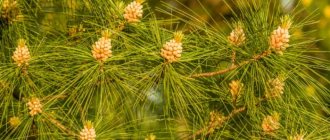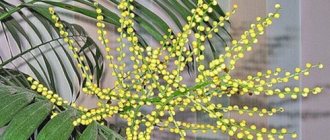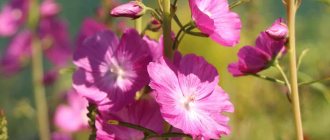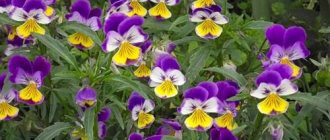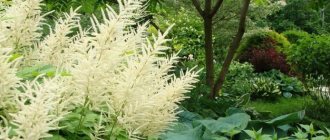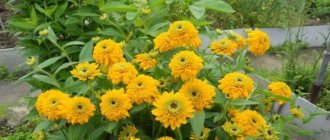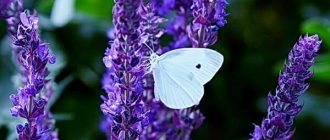Daisies flowers
The ancestor of the cultivated varieties was a field species that is widespread on the plains of the Mediterranean. The plant is unpretentious, but spectacular. There are many varieties and types.
Variety of daisies
Origin and appearance of the daisy plant
Bellis is a perennial plant that belongs to the Asteraceae (Asteraceae) family. The name is translated from Latin as “beautiful, wonderful”, from Greek – “pearl”. Many other countries have their own names for the flower.
The origin always begins in beautiful legends - every nation has its own interpretation. The plant is considered very fashionable, so one of the varieties can be found in almost any well-kept garden or in a good flower bed.
Wild daisies
Everyone can tell what daisies look like, since they have seen these flowers at least once in their life. There are several varieties that differ in their appearance. The “calling card” of a flower is the color and structure of the buds.
Description of the daisy flower
To recognize this type of flower among others, you need to know what it looks like. Its main features:
- The above-ground part is a bush, the height of which is no more than 20 cm.
- The stem is bare, and only in the area of the ground itself can there be several narrow long leaves.
- The root is branched, but occupies a minimum area under the bush.
- There are many inflorescences on the bush.
- Inflorescences can be a tongue-shaped or tubular version of the petal shape.
- The color range includes more than 100 shades. The most popular colors are: yellow, pink, white, lilac, burgundy, as well as their combinations.
Appearance of buds and stems
Interesting! The plant has a unique “character”. For example, its buds open after sunrise and close after sunset. Bushes bend to the ground in windy weather.
When do perennial daisies usually bloom?
Gardeners are trying to grow perennials, since every year the flowering becomes more luxuriant. You can usually enjoy timely flowering in the second year of the flower's life.
Daisies bloom from late April or early May. In the first year, the appearance of buds may be delayed and may even appear at the beginning of June.
How long do daisies bloom?
If you properly care for the crop, the buds will decorate the inconspicuous bush for about 2-3 months.
Additional Information! In hot weather, daisies can stop flowering and resume when the weather returns to normal.
Some varieties have longer flowering periods - often the inflorescences can be observed until frost.
Daisy flowers: legends and beliefs
The word "daisy" is derived from the word "margarites". Which means “pearl” in Greek. According to one legend, the little Virgin Mary loved to look at the sky in the evenings. She wanted the stars to become flowers that she could play with. The stars sparkled in the droplets of emerging dew like pearls. And the next day, in place of the dew drops, beautiful flowers appeared - daisies.
Russian legends also mention this flower and pearls. The legend about Sadko says that when he came ashore, his wife Lyubava rushed to her lover and scattered her pearl necklace. In the places where the pearls fell, daisies appeared.
The daisy is sung by many poets. Shakespeare said about this flower, “Her white robe represents naivety.” Pliny called this flower Bellis "beautiful". This is the word used today to call the genus of this flower.
Daisies are revered throughout Europe. In France, it is customary to give these flowers a week before Easter (analogous to our Palm Sunday). Daisies decorate the windows of houses, gardens and parks. It’s a pity, but today these beautiful flowers are gradually being replaced by tulips, daffodils and hyacinths.
Daisies are very popular in England. Songs and legends are dedicated to them. With their help, girls tell fortunes by tearing off the petals of a daisy “loves or dislikes.” In German culture, this is why daisies are called “the measure of love.” And boys, for the quick onset of spring, they must step on 12 forget-me-nots.
Flower of Love
Medieval knights, who received consent for marriage from their lovers, placed an image of this flower on their shields. Most likely, this legend is associated with Countess Margaret, who gave this flower to Count Orlando before going on the Crusade. The count fell in battle, but his friends brought a flower to his beloved. It was stained with the blood of Count Orlando. Margarita planted the seeds of this flower in memory of her beloved.
Since daisies are the first to bloom in the garden, they are also called the “Day's eye”. The English shorten the name of daisies to Daisy .
There is another legend associated with this flower. One rich old man fell in love with a beautiful but young girl. Her poor parents were not averse to giving their daughter in marriage to a rich old man. But the girl didn’t want this and ran away. And in order not to be found, she asked the earth to hide her. The earth turned the girl into a daisy that blooms all year round.
At the beginning of the 20th century in Europe, daisies were used to raise money to fight tuberculosis. This experience was first gained in Sweden, where these popular flowers were sold and the proceeds were donated to hospitals. Later other European countries joined in. In Moscow, such an action was carried out in 1910. The sale of daisies generated 150 thousand rubles. Russian newspapers were full of headlines that Muscovites “threw flowers at death.”
Surprisingly, with such a love for daisies, these flowers also had a black stripe. In 1739 in Germany they were called poisonous and called for extermination. But daisies survived and delight us today with their magnificent beauty.
Types and varieties of daisies
What are gerbera flowers - what they look like and how they grow
There are wild and domesticated species. There are 14 species in nature, but only 2 are used in gardening - annuals and perennials. Annuals are usually planted in pots or cache-pots, while perennials are grown in flower beds and gardens. At the same time, domestic species include a lot of varieties, each of which has its own distinctive features.
Daisy Tasso
The Tasso daisy has the following description:
- bush 12 cm high;
- tubular petals, collected according to the pompom principle into inflorescences;
- The colors of the buds can be varied, but the most popular options remain white and pink.
Tasso is considered an improved version of Pamponetta.
Variety Tasso
Daisy Pompom
The pompom variety is one of the first selectively bred in France. It is distinguished by lush flowering - about 40 buds can bloom on 1 bush at one time. At the same time, the buds are small (about 2 cm in radius), but fluffy.
Variety Pompon
Daisy Habanera
A popular variety among lovers of rich colors. Basically, the color of the petals is close to burgundy, but the white-burgundy version is considered especially popular. The buds have a diameter of about 6 cm, the petals are terry and voluminous.
Habanera variety
general description
Daisies look beautiful not only when in bloom , their unusual lobe-shaped leaves delight the eye with lush greenery from early spring until frost.
Daisies belong to the Astrov family; officially there are more than 80 species of this biennial , which have their roots in Europe, America, and Australia. They were the first to make their way from fields to gardens; by the beginning of the 16th century, there were several terry varieties in the selection.
They were cultivated in the palace parks of England, France, and Italy. Flowers quickly spread to city parks, and not only white, but also red daisies were known.
Daisies in decorative pots
From Latin, daisy is literally translated as “pearl ,” and this is exactly what these flowers look like on lawns when they grow among short grass. A well-groomed flower bed with daisies will look a little different,
The leaves will show off with lush greenery, flowers will delight the eye several times a season. Usually the first flowering takes place in early spring, daisies take over the baton from tulips and daffodils, the second time Asters of this species will bloom closer to autumn, when the heat subsides and there is enough moisture to restore the vitality of the trunk.
It is difficult to confuse a daisy with another flower; it has a number of features:
- Small in height, daisies rarely reach 30 cm.
- The leaves sit tightly next to each other and have a lobe-like shape.
- The inflorescence has the shape of a basket.
- The flowers do not rise very much on the rosette of leaves, no more than 3-5 cm.
- The center of the flower is always yellow, framed by outer petals that have a reed or tubular shape.
Each bush at one time can please you with 30 peduncles with fully developed flowers.
The stem is classified as asteraceae and is distinguished by the following subspecies:
- simple
- semi-double
- terry
The flowering time will also vary; there are early and late varieties, the timing differs by 2-3 weeks . Flower size also divided daisies into small, medium and large-flowered varieties.
Daisies with large baskets bloom much later than all their relatives, but the period is much longer.
Growing daisies from seeds
Calla lilies flowers - what they look like and what the varieties and varieties are called
Growing daisy flowers is not difficult. They are mainly bred by sowing seeds. This happens in the spring. There are 2 sowing methods - seedlings with further replanting in flowerbeds or sowing in open ground. Next, the seedlings are grown.
An ideal plant for beginning gardeners
Even a beginner can cope with germinating seeds, growing seedlings and growing flowers. The plant is unpretentious, does not require special attention, but at the same time pleases with its flowering. Flower growers recommend this crop for planting in public flower beds, where watering and weeding are done quite rarely. Even a child can cope with growing and caring for it.
Growing daisy seedlings
Growing daisy seedlings begins with sowing, and then the following stages follow:
- preparing appropriate conditions for growing;
- seedling care;
- determining the time for experiencing sprouts;
- picking seedlings;
Then the small seedlings are cared for in the open ground.
Growing seedlings from seeds
Stratification and planting of daisy seeds
The first question that interests novice gardeners is - when to plant daisies with seeds? There are several options for determining the sowing period. It is preferable to sow planting material in early January and February. It is better to choose granulated seeds, which are covered with a special coating of nutrients.
Sowing algorithm:
- prepare containers with loamy soil;
- make grooves in the soil at a distance of 2 cm from each other;
- spread out the seeds;
- spray with a spray bottle;
- cover with film to create a greenhouse effect.
Important! Planting material cannot be covered with soil.
If the procedure is carried out on time and correctly, the daisies will bloom in the first year.
Conditions for growing daisy seedlings
Daisies grow from seeds to seedlings within 1-2 months. Much depends on the conditions and plant variety:
- The room must always be +25 °C.
- If the days are cloudy, you need to install lamps above the container with the sprouts.
- When seedlings appear, remove the film and reduce the air temperature to +20 °C.
Daisy seedlings
Watering is carried out as the soil dries. It is advisable to spray so as not to wash the sprouts.
When to plant daisy seedlings in open ground
3 months after sowing, you can begin planting seedlings in open ground. This usually happens in mid to late May. If the weather is warm, then the procedure can be performed even in early May.
Picking seedlings
If you have no experience in picking seedlings, then it is better to initially take care to avoid this. It is enough to plant the seeds in peat cups, which are planted in the ground without removing the earthen clod from the root system.
Seedlings for planting
Reproduction
Garden daisies are usually purchased at garden centers as a spring flower already in bloom. However, it is worth trying to grow your own daisies from seed or vegetatively.
Seeds
This way you can get a lot of young plants, which next year will become a real decoration in the garden, on the balcony.
It is better to purchase seeds for sowing at a gardening store. They are obtained through selection, and thanks to this we will get exactly the plants we want.
When is the best time to sow daisy seeds? The best time to sow seeds is June, then they will have time to grow before autumn. The ideal temperature for seed germination is 18 °C.
Seeds are sown in the garden as follows:
- A small area is prepared for seedlings, which is first cleared of weeds, the ground is loosened, dug up, and compost is added at the same time.
- The soil is carefully leveled with a rake.
- Make shallow furrows (1 cm) and sow seeds in them.
- The seeds are covered with a not very thick layer of soil and the soil is kept moist. Don't forget to weed the seedlings regularly.
- When the plants produce 3-4 leaves, we pick them out one at a time to provide them with the best conditions for further development.
- At the end of August - September, the young daisy is ready to be planted at its destination. Daisy seedlings are planted in a permanent place at intervals of 20 × 20 cm.
- For growing to be successful, young plants must be protected from frost over the winter. Coniferous tree branches are used for shelter.
Plants obtained in this way can be used to decorate the borders of flower beds, paths, and lawns. They will be magnificent as potted flowers and will be an excellent decoration for the balcony and home. Garden daisies grown from seeds will bloom next spring.
Vegetatively
Daisies can be propagated vegetatively. To do this, in the spring, the shoots that the mother bushes produce are separated, planted in the ground and placed in a warm place. Young plants need to be watered regularly. To create optimal conditions for rooting, it is worth using a film tent, which is placed above the pot with seedlings. This way we will limit the evaporation of water and ensure constant humidity of the substrate. The seedlings take root quickly and young plants will appear in a few weeks.
Daisies can be propagated by division. Carefully dig out several rosettes with roots. You need to dig up the plants along with the entire root system, which goes quite deep into the ground. After moving to the destination, you need to make sure that the holes are deep enough - all the roots should be hidden in the ground. It is better to pre-prepare holes in several places on the lawn and add soil for flowers into them. After this, tiny flowers are planted in the holes.
Next year, a dozen new flowers should appear, which will multiply successively every year. New plants can be brought into the garden from natural meadows, they are extremely resistant to weather conditions, are not afraid of frost, and the flowering period is really long.
Reproduction of daisies by dividing the bush
The bush is divided after 2 years in order to rejuvenate the plant. The procedure is carried out as follows:
- Divide before or after flowering.
- Carefully dig up the bush and divide the root system according to the number of stems.
- Cut off leaves and dry (withered) buds.
- Trim root shoots.
Reproduction of daisies
Plant new bushes in prepared soil. The process is not too long and provides a faster reproduction option.
What you need to plant daisies
Planting is done simply and efficiently if everything is prepared for this procedure:
- Choose a good place to plant.
- Prepare the substrate.
- Treat the soil.
Next, you need to organize proper care for the sprouts.
Choosing the optimal location
Growing daisies is easy if you choose the right location in the first place. The culture prefers open areas where the bush will be illuminated by direct sunlight. But aggressive exposure can lead to sunburn, so you need to plant a taller type of plant nearby.
Selection of location and soil
Diseases and pests of daisies
The daisy is unpretentious and many diseases are not scary for it. But it is susceptible to diseases such as gray rot, rust, powdery mildew. The plant can also be damaged by rodents and insects.
Gray rot
The cause of the disease is damp, cold weather. The appearance of the bush is watery leaves with a gray coating. Disinfection is the removal of the infected part of the plant. Prevention - reducing humidity. Preparations for treatment - “Skor”, “Chistotsvet”.
Rust
The cause of the disease is a fungal infection. The appearance of the bush is leaves with rusty red or brown spots. Disinfection is the removal of the infected part of the plant. Prevention - destruction of plant residues, loosening. Preparations for treatment - 1% solution of Bordeaux mixture.
Powdery mildew
The cause of the disease is oversaturation of the soil with nitrogen fertilizers and lack of moisture. Appearance of the bush - the leaves darken, a white coating appears on top and bottom. Disinfection - removal of the infected part of the plant or destruction of the entire bush. Prevention - destruction of plant residues, thinning. Preparations for treatment - “Chistotsvet”, “Fitosporin”, “Trichodermin”.
Brown spot
The cause of the disease is infection of the plant by bacteria. Appearance of the bush - the leaves are covered with light spots with a border. Disinfection - removal of the infected part of the plant or destruction of the entire bush. Prevention - destruction of plant residues, loosening. Preparations for treating the plant - “Kuprotox”, “Hom” Preparations for treating the soil - solution of iron sulfate, 3% solution of Bordeaux mixture.
To protect flowers from animals - rodents: mice, shrews, moles - poisoned bait is left on the site. Make sure that pets are not poisoned by it.
Insects that can harm daisy plantings (spider mites and thrips) are destroyed by repeated spraying of the plant and soil. For spraying, use solutions of laundry soap, celandine, Aktara, and Iskra.
Daisies in landscape design
To decorate a garden with a plant, you need to choose a suitable place for it in the landscape design:
- Daisies look original against a green lawn.
- They go well with hyacinths, tulips, and daffodils.
- Harmonizes with coniferous trees.
Daisies in landscape design
To visually make the house bright, it is worth planting huge flower beds with bushes of different colors near the facade.
Mr. Summer Resident advises: daisies in the landscape
This is an unpretentious plant that is very loved by garden and park designers for its long, abundant flowering and excellent combination with other crops.
Daisies form a carpet of various shapes and colors. That's why they are often planted:
- next to daffodils, tulips, hyacinths in flower beds;
- around ponds and reservoirs (they like moist soil);
- on Moorish and meadow lawns;
- as a group planting (10-15 bushes, crowded);
- small bushes on alpine hills;
- florists use it to make wedding bouquets.
They grow them on the balcony and decorate gazebos and terraces with flowerpots with them.
Caring for daisies in the garden
Perennial daisies, planting and caring for which are not difficult, remain in a vegetative state for a long time. But it is still worth paying attention to some nuances.
Feeding daisies for lush flowering
You can grow a lush bush if you carry out three-stage feeding:
- immediately after the thaw - nitrogen fertilizers;
- at the moment the first buds appear - complex fertilizers;
- before winter - humus.
Important! The plant does not require additional fertilizing.
Features of transplantation and protection from pests
An important condition for normal development is protection from pests. The following pests most often affect crops:
- spider mite;
- thrips;
- small rodents.
If pests are identified, then it is worth immediately taking measures to destroy the “undesirable guests”.
Seed collection and disease exposure
During drought, the following diseases may occur:
- powdery mildew;
- gray rot;
- red rust.
It is necessary to treat the plant with a fungicide and ensure normal watering. After healing, you need to collect seeds from daisies:
- Tear off the dry box.
- Pour the contents onto paper and dry.
- Place planting material in paper bags.
Important! Seeds can be stored for no more than 3 years.
Collection of dry seeds
Preparing daisies for winter
During cold weather, it is worth preparing the plant for winter:
- Hill up the bushes where the transition of the stem to the root system is exposed.
- Cut off leaves and buds.
- Sprinkle the specimens with dry leaves or sawdust.
There is no need to especially surround the crop with care before wintering - it is enough to carry out the simplest measures.
You can decorate a balcony, flowerbed, or garden with culture. The plant is not whimsical and blooms luxuriantly almost all summer. Typically, different varieties of perennial daisy are used for cultivation. The crop can be propagated by cuttings, seeds and dividing the bush. Many gardeners prefer this particular type of aster.
Planting daisy seedlings in open ground
Perennial daisies photo planting and care
In order for the flower to grow and not get sick, it is necessary to choose the right site and soil composition. Daisy loves bright lighting. An area near the trunk of a tree, in partial shade, is also suitable for her. Only the Cape daisy prefers bright sunlight, but in the shade it fades and loses its colors.
The plant prefers soil that is light, drained, and moisture-permeable. Loam with neutral acidity is best suited. If the soil on the site is sandy, then it is mixed with manure, leaf soil, humus, ash, and peat.
Perennial daisies grown from seeds are planted in a prepared area 30 days after picking. Transplantation is performed with a clod of earth to preserve the root system of the seedling. The distance between young daisy bushes is up to 20 cm.
It is not worth planting less often, as the effect of group planting will be disrupted. Also, flowers planted strictly in a line will not look interesting. After planting, you need to water the plants with plenty of water.
Interesting fact. Perennial daisy loves transplants. They activate the growth and development of the plant even at the stage of flowering and bud formation.
Plant propagation
Vegetative propagation methods allow preserving the varietal characteristics of the plant.
P
The procedure is carried out in the second year after planting or in subsequent years.
Dividing the bush
It is best to divide biennials in the spring, before budding, or in the fall.
The overgrown bush is carefully dug up and cut into several parts.
The green mass is removed from the cuttings, the roots are trimmed, and the sections are dusted with wood ash.
Daisies are planted in open ground immediately. The pre-prepared holes are then filled with soil and watered well.
Cuttings
Planting daisies can be done in another vegetative way.
The bushes are propagated by cuttings in June; side shoots are used for work.
They are separated with a sharp knife and immediately planted in open ground. It takes several weeks to root.
A rooted cutting will require the same care as an adult bush. The plant obtained from the cutting will bloom the next year.
Other varieties
Miniature daisies are considered less common; it is advisable to grow such varieties in small flower beds and should be given great attention. If not properly cared for, they quickly become overgrown with weeds and become almost invisible in the grass.
These include babies:
- "Dresden China" (Dresden China)
- "Liliput"
- "Alice"
Miniature daisies
Such varieties are often planted in public parks in England, gradually growing in the grass throughout the park. They are not afraid of the lawnmower; as it passes, it only cuts off the tops of the flower stalks, and in this way the bush itself is stimulated to bloom again.
I would like to pay special attention to the variety:
"Hens and Chickens"
"Hens and Chickens"
- Which literally translates to Hen and Chicks. The main feature of the variety is the fouling of the central basket with secondary ones; visually they form a sort of halo.
- This is how the variety got its name because one daisy includes a hen, around which the chicks have settled.
- This variety was first described back in the 16th century, where by association it was equated to a wreath. Nowadays, such daisies are rarely grown; only a few gardeners have such a Hen.
- Small varieties are less popular, and the variety is growing every year, but some do not ignore these garden flowers.
Description of the plant
The daisy is a herbaceous plant, small in size with small inflorescences. The root system is short, fibrous.
Photos of flowers Daisy
The foliage is spatulate and blunt, forming basal rosettes. The leafless stems are crowned with only one flower. A white or pink inflorescence appears on a conical peduncle, in the middle of which there are yellow tubular flowers.
Daisy flowers of simple, semi-double and double form are grown in the culture. After flowering, achenes are formed, brown in color and flattened in shape.
How to grow?
Bush of daisies in the open ground
It is not difficult to grow daisies in open ground ; if all the necessary conditions are correctly met, the plant will delight you with regular flowering for many years and will become an excellent decoration for any flower bed or lawn.
In order for the flower to feel great, grow and have a long flowering period, it is worth regularly performing the following care measures:
- regularly remove weeds from bushes
- avoid thickening
- apply fertilizing in a timely manner
- loosen the soil around the trunks
- help with watering in hot weather
If slightly wilted baskets of inflorescences are cut off or pinched, the flower will soon begin to produce flower stalks again.
The cultivation of daisies itself has several stages; following them will help you have ideal specimens that exactly match the variety.
Among flower growers, the following stages are distinguished:
1Growing seedlings in closed or open ground
2Transplant to a permanent place
3Care
Each of the points should be taken responsibly; the further growth and flowering of daisies in your garden or flower bed depends on correct implementation.
We grow seedlings
To achieve faster flowering of many varieties of daisies, flower growers practice germinating seeds for seedlings. The process is quite labor-intensive, but the results will be the best reward for your efforts.
The process consists of several steps:
1The pre-collected soil is warmed up well for several days
2Water generously and let dry a little
3In the container, shallow grooves are made in the soil, up to 2 cm
4The seeds are pre-soaked in a weak solution of potassium permanganate or any fungicide
5Dry slightly
6In the grooves the seeds are placed at a distance of about 2-3 cm
7Sprinkle the top with soil and place it on a bright, warm windowsill
8Water the container periodically
In about 2-3 weeks the first shoots should appear, they will actively grow and develop
Babies can be planted in open ground only after hardening and only when the threat of frost has passed . Young plants will not have time to take root at low temperatures and will die, unable to withstand the stress. They begin to sow in early March, and enjoy the results in the second half of summer.
To speed up the similarity of seeds, you can create greenhouse conditions, cover the container with glass or wrap it with film. At the same time, do not forget to regularly ventilate and water the container with seeds. Under such conditions, daisies will begin to hatch in 10-15 days.
You can germinate seeds in open ground, but under a film, by building a mini-greenhouse. To do this, they usually prepare the ground in the place where daisies are planned to grow. Seeds are sown according to the same principle, and covered with film on top. On fine sunny days the cover must be removed.
Transplantation to a permanent place
When the plant has 2-3 true leaves, it must be transplanted to a permanent place of residence. This is done with all types of seedlings; they are planted completely from pots and boxes, and those sprouted in open ground under a film are thinned out.
Daisy shoots two weeks before planting
In open ground under normal weather conditions, annual daisy bushes should be 10-15 cm apart from each other. It is at this distance that they are planted in the flowerbed.
Next, they themselves will regulate the optimal distance, but for high-quality flowering they will still have to thin out the bushes.
When transplanting to a permanent place, it is worth taking into account the short stature of the plant; daisies are usually planted in the first row in multi-layered flower beds, on the lower tier of ridges and alpine slides. If you plan to plant a wide flowerbed, then the daisies should be located near the very edge, otherwise they will simply be drowned out by the rest of the inhabitants.
When transferring seedlings from a container to open ground, you should carefully monitor the weather; the process itself looks like this:
1 Make grooves in the selected location
2Each of them is watered abundantly
3The seedlings are also watered
4Carefully pull the seedlings out of the container, making sure not to damage the root system
5Lay out the babies in the furrows
6Sprinkle with soil and lightly compact the earth around each of them
7Wiring will be the final stage of planting
If you plan to grow plants in pots and cache-pots on balconies and terraces, then they will not need replanting. It is enough to simply thin out the seedlings, leaving the strongest specimens
Care after transplant
Care tool
After transplantation, the gardener should make some efforts for successful rooting. Without supervision, the plants will quickly die; only the strongest will be able to survive.
To speed up rooting and prevent the death of sprouts, you should take the following actions:
- water as the soil dries out
- protect from direct sunlight, slightly shade the planting site
- Once a week, lightly loosen the soil around the trunks
You should not feed the seedlings at first , this can have a detrimental effect on their development, and a high concentration can even destroy the plants.
Daisies in pots will only require watering and shady places, they will already have everything else
Other types of reproduction
Daisies can be propagated not only by seeds; dividing the bush in autumn or spring will help with this. The time for carrying out the procedure should be chosen so that the plant has time to take root before the onset of frost or extreme heat, most often this is the first half of May or the end of August.
Dividing the bush
It is during this period, before or after flowering, that side shoots actively develop, which are usually separated in order to rejuvenate the trunk or plant it in a large area of the garden.
The bush must be divided correctly:
- it is advisable to dig it out completely in order to better draw conditional lines for division
- when dividing, it is important to take into account the state of the horse system; each separated mini-bush must have well-developed roots
- the presence of lush foliage is not necessary; even from one leaf, with strong and healthy roots, a full-fledged bush will quickly develop
- after separation, it is advisable to treat the cut with charcoal or sprinkle them with ground cinnamon
- Separated parts should be planted in grooves, it is advisable to make them 3-4 cm deep
- Watering during planting is carried out with sufficiently heated water
- As soon as the water is absorbed, the grooves are filled with soil and lightly pressed down around each plant, forming a small depression for watering
- after 2-3 weeks, the separated bushes will take root and begin their development
If the bush was divided in the spring, you should not expect flowering this year, but next spring the daisies will delight you with riotous flowering, which will repeat in late summer and early autumn. Divided in the autumn and having managed to take root, they will bloom in the coming spring if wintering goes well.
Choosing soil and planting site
Almost any soil is suitable for growing daisies in the garden and flower beds; the main condition is excellent drainage and a sufficient amount of nutrients.
If water stagnates at the place of growth in the spring or during rain, then the daisies will not take root there; they will get wet there. But lack of moisture in the summer heat can also destroy beauties.
Preparing the soil for planting
When choosing a place to plant garden beauties, it is worth considering some nuances:
- daisies do not tolerate direct sunlight, it is harmful to them
- the plant will feel great in partial shade and shade
- places that are flooded in the spring are also not suitable, the daisies will simply get wet
- lack of moisture in summer will destroy plants
In order for the trunks to feel good, grow and develop, it is worth preparing a soil mixture consisting of 2 parts sand, 4 parts garden soil, 1 part humus. All ingredients are mixed well and poured into the place where you plan to plant prepared seedlings or purchased bushes.
Plants should be fed periodically ; this is another component of regular flowering.
Feeding
All plants in the garden need moisture and nutrients for normal growth and development ; without these components, most plants will not have normal flowering, and therefore seeds will not be able to form. Garden varieties of daisies are no exception; they also need feeding.
After replanting into prepared soil, in which one of the components was a small part of humus, at first there is no need to feed the plants , but later, after about a month and a half, the trunks must be periodically watered with the addition of mineral fertilizers.
Fertilizer application
For further support, daisies are fertilized every two weeks , with preference given to water-soluble preparations with a high nitrogen content.
To feed daisies, 10 liters of water, in which 20 g of the substance are dissolved, is enough.
The second year of life of daisies begins with feeding in early spring . The solution is prepared according to standard proportions for the plant, then until autumn, fertilizers are applied every 2-3 weeks. Particular attention is paid to the flowering period; there you can feed more often.
Several times during the season, gardeners recommend fertilizing with organic matter; most often for this type of garden flowers, an infusion of chicken manure or mullein is used. The product is prepared in a ratio of 1:10, if you increase the concentration you can burn the bushes, so strictly monitor the amount of substance added to the water for irrigation.
